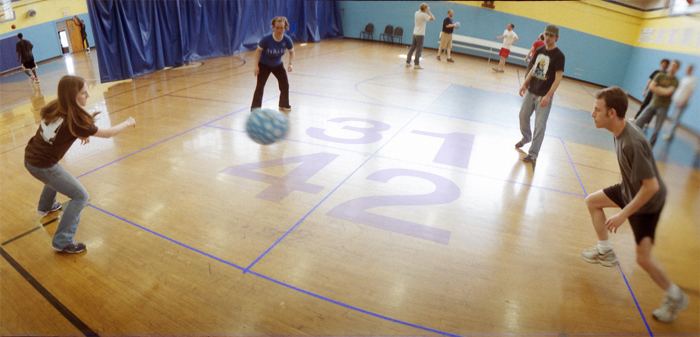Players 4 | Setup time 30 seconds | |
 | ||
Skill(s) required Manual dexterityStrategySocial skills | ||
Four squareis a ball game played among four players on a square court divided into quadrants. It is a popular game at elementary schools with little required equipment, almost no setup, and short rounds of play that can be ended at any time.
Contents
- Playing environment
- Ball usage
- Elimination
- Modifications
- Game scalability
- History
- World championships
- World records
- References
Four square is usually played with a rubber playground ball, on a square court with four maximum players. The objective of four square is to eliminate other players to achieve the highest rank. A player is eliminated when a ball is bounced in a player's quadrant and the player is unable to touch the ball into another player's quadrant.
Playing environment
Four square is played on any hard-surfaced court, such as wood, concrete or asphalt. There is no official court size, but typically courts measure between 10 and 20 feet on a side, and divided into four smaller equal-size squares. Each of the four squares has a rank and is occupied by a single player. The ranks may be arranged so that either the highest ranking square is positioned facing the lowest ranking square, or the ranks increase as one moves clockwise (or counterclockwise).
The lines on the court are boundaries. The interior lines separating player squares are out of bounds. The ball may not touch any portion of an inside line or the player who hit the ball is in error. In recreational play, and even with a judge in tournament play, it is often difficult to determine if the ball hits the line.
The lines marking the outermost edges of the court are typically considered in-bounds. If a ball lands on or touches the inside lines then the last person to touch the ball is eliminated. These boundary rules are often described as "inside out, outside in."
Ball usage
Four square is played with a rubber playground ball, typically 8.5" diameter, and inflated to 2 lbs. However, other sizes and types of balls can also be used.
During regular play, or "classic," the ball must be hit with the player's hands only.
In classic play, carrying, catching, or holding the ball during play is not allowed, although putting spin on the ball is allowed as long as carrying does not occur. Prolonged contact with the ball can give players unfair control over the play. Hitting the ball must create a perceptible change in the ball's velocity (speed or direction).
Elimination
Players may be eliminated from the court because of errors or fouls they commit. Eliminated players leave the court, the remaining players move up to the next highest square, and a new player joins the court in the lowest square. Eliminated players wait in line for their next turn.
The following actions may result in elimination (although many variations exist):
Modifications
In recreational games, the highest ranking player, often known as the "king", may modify the game's rules at the beginning of each round. Many modifications either expand or constrain the legal methods of ball handling. Typically a player must "win" a point in the highest square before being able to invoke a new rule. Children refer to these modifications with elaborate local and regional nomenclatures.
Game scalability
Four square is a popular game for children and school playgrounds. It is possible to scale the game's difficulty and supervision appropriately for different age groups and ability levels. Schools, churches, and camps often change the size of the court, the type of ball, or aspects of the rules to create variation in play or to suit the players' abilities.
History
Four square dates back to at least the 1950s. A game called "four square" is mentioned in newspapers at least as far back as the 1950s, although the rules are not explained.
Four Square is described with the same rules used today in a 1963 teacher's manual.
World championships
The Four Square World Championships, a competitive adult four square tournament, takes place in Bridgton, Maine, USA, each winter season. Peter Lowell of the Lakes Environmental Association hosts this annual fundraiser each winter to support the environmental work done in the lakes region of Maine, USA. This competition draws athletes from the USA and Canada, and has registered competitors from Israel to Bermuda. As of February 22, 2014, the titles are held by:
(Division I includes ages 13 through 39. Division II includes ages 40 and up.)
Prior world championships have been held on January 29, 2005, January 28, 2006, February 3, 2007, February 16, 2008, February 28, 2009, February 27, 2010, February 26, 2011, February 25, 2012, February 23, 2013, and February 22, 2014.
World records
On August 4–5, 2012, a core group of 17 Needham High School students and alumni — assisted by 50 other Needham residents at various times — broke the previous world record by playing for 34 hours, the previous record being held by 15 Manchester College students who played the game for 30 hours. The world record was previously held by eight Argentinean players for 29 hours in 2008, as recognized by Guinness World Records. The Argentinean record was preceded by a group of teens from Youngstown, OH who also played for 29 hours.
